Effects of Full Chain Processes on the Performance of 316L Stainless Steel Composite by Fused Deposition Modeling and Sintering
Abstract
:1. Introduction
2. Materials and Methods
2.1. Materials
2.2. Experimental Procedure
2.3. Characterization Methods
3. Results and Discussion
3.1. Green Samples’ Tensile Properties
3.2. Debound Samples
3.2.1. DSC Analysis
3.2.2. Microstructure
3.3. Sintering Samples
3.3.1. Microstructure
3.3.2. Mechanical Properties
3.4. Orthogonal Experiment
4. Conclusions
Author Contributions
Funding
Data Availability Statement
Acknowledgments
Conflicts of Interest
References
- Herzberger, J.; Sirrine, J.M.; Williams, C.B.; Long, T.E. Polymer design for 3D printing elastomers: Recent advances in structure, properties, and printing. Prog. Polym. Sci. 2019, 97, 101144. [Google Scholar] [CrossRef]
- Pollack, S.; Venkatesh, C.; Neff, M.; Healy, A.V.; Hu, G.; Fuenmayor, E.A.; Devine, D.M. Polymer-Based additive manufacturing: Historical developments, process types and material considerations. In Polymer-Based Additive Manufacturing; Springer: Cham, Switzerland, 2019; pp. 1–22. [Google Scholar] [CrossRef]
- Shahrubudin, N.; Lee, T.C.; Ramlan, R. An overview on 3D printing technology: Technological, materials, and applications. Procedia Manuf. 2019, 35, 1286–1296. [Google Scholar] [CrossRef]
- Khairallah, S.A.; Anderson, A.T.; Rubenchik, A.; King, W.E. Laser powder-bed fusion additive manufacturing: Physics of complex melt flow and formation mechanisms of pores, spatter, and denudation zones. Acta Mater. 2016, 108, 36–45. [Google Scholar] [CrossRef]
- Frazier, W.E. Metal Additive Manufacturing: A Review. J. Mater. Eng. Perform. 2014, 23, 1917–1928. [Google Scholar] [CrossRef]
- Ravalji, J.M.; Raval, S.J. Review of quality issues and mitigation strategies for metal powder bed fusion. Rapid Prototyp. J. 2023, 29, 792–817. [Google Scholar] [CrossRef]
- Piscopo, G.; Iuliano, L. Current research and industrial application of laser powder directed energy deposition. Int. J. Adv. Manuf. Technol. 2022, 119, 6893–6917. [Google Scholar] [CrossRef]
- Gibson, I.; Rosen, D.; Stucker, B.; Khorasani, M. Powder bed fusion. In Additive Manufacturing Technologies; Springer: Cham, Switzerland, 2021; pp. 125–170. [Google Scholar]
- Ahn, D.G. Directed energy deposition (DED) process: State of the art. Int. J. Precis. Eng. Manuf.-Green Technol. 2021, 8, 703–742. [Google Scholar] [CrossRef]
- Singh, D.D.; Mahender, T.; Reddy, A.R. Powder bed fusion process: A brief review. Mater. Today Proc. 2021, 46, 350–355. [Google Scholar] [CrossRef]
- Pilipović, A. Sheet lamination. In Polymers for 3D Printing; William Andrew Publishing: Norwich, NY, USA, 2022; pp. 127–136. [Google Scholar]
- Grasso, M.; Remani, A.; Dickins, A.; Colosimo, B.M.; Leach, R.K. In-situ measurement and monitoring methods for metal powder bed fusion: An updated review. Meas. Sci. Technol. 2021, 32, 112001. [Google Scholar] [CrossRef]
- Li, Z.; Sui, S.; Ma, X.; Tan, H.; Zhong, C.; Bi, G.; Clare, A.T.; Gasser, A.; Chen, J. High deposition rate powder-and wire-based laser directed energy deposition of metallic materials: A review. Int. J. Mach. Tools Manuf. 2022, 181, 103942. [Google Scholar] [CrossRef]
- Izadi, M.; Farzaneh, A.; Mohammed, M.; Gibson, I.; Rolfe, B. A review of laser engineered net shaping (LENS) build and process parameters of metallic parts. Rapid Prototyp. J. 2020, 26, 1059–1078. [Google Scholar] [CrossRef]
- Zhong, C.; Liu, J.; Zhao, T.; Schopphoven, T.; Fu, J.; Gasser, A.; Schleifenbaum, J.H. Laser metal deposition of Ti6Al4V—A brief review. Appl. Sci. 2020, 10, 764. [Google Scholar] [CrossRef]
- Gong, X.; Anderson, T.; Chou, K. Review on powder-based electron beam additive manufacturing technology. In Proceedings of the International Symposium on Flexible Automation, St. Louis, MO, USA, 18–20 June 2012; American Society of Mechanical Engineers: New York, NY, USA, 2012; Volume 45110, pp. 507–515. [Google Scholar]
- Bankapalli, N.K.; Gupta, V.; Saxena, P.; Bajpai, A.; Lahoda, C.; Polte, J. Filament fabrication and subsequent additive manufacturing, debinding, and sintering for extrusion-based metal additive manufacturing and their applications: A review. Compos. Part B Eng. 2023, 264, 110915. [Google Scholar] [CrossRef]
- Singh, G.; Missiaen, J.M.; Bouvard, D.; Chaix, J.M. Copper extrusion 3D printing using metal injection moulding feedstock: Analysis of process parameters for green density and surface roughness optimization. Addit. Manuf. 2021, 38, 101778. [Google Scholar] [CrossRef]
- Thompson, Y.; Gonzalez-Gutierrez, J.; Kukla, C.; Felfer, P. Fused filament fabrication, debinding and sintering as a low cost additive manufacturing method of 316L stainless steel. Addit. Manuf. 2019, 30, 100861. [Google Scholar] [CrossRef]
- He, T.; Zhang, S.; Kong, X.; Wu, J.; Liu, L.L.; Wu, D.; Su, Z. Influence of diamond parameters on microstructure and properties of copper-based diamond composites manufactured by Fused Deposition Modeling and Sintering (FDMS). J. Alloys Compd. 2023, 931, 167492. [Google Scholar] [CrossRef]
- Wen, L.J.; Hu, X.G.; Li, Z.; Wang, Z.H.; Wu, J.K.; Zhu, Q. Anisotropy in tensile properties and fracture behaviour of 316L stainless steel parts manufactured by fused deposition modelling and sintering. Adv. Manuf. 2022, 10, 345–355. [Google Scholar] [CrossRef]
- Malhotra, M.K.; Grover, V. An assessment of survey research in POM: From constructs to theory. J. Oper. Manag. 1998, 16, 407–425. [Google Scholar] [CrossRef]
- Shubhra, Q.T.; Alam, A.M.; Quaiyyum, M.A. Mechanical properties of polypropylene composites: A review. J. Thermoplast. Compos. Mater. 2013, 26, 362–391. [Google Scholar] [CrossRef]
- Klingshirn, C. ZnO: Material, physics and applications. ChemPhysChem 2007, 8, 782–803. [Google Scholar] [CrossRef]
- Du, J.B.; Tang, Y.L.; Long, Z.W.; Shuang, H.H.; Tao, L. Theoretical calculation of spectra of dibutyl phthalate and dioctyl phthalate. Russ. J. Phys. Chem. A 2014, 88, 819–822. [Google Scholar] [CrossRef]
- Martin, J.H.; Yahata, B.D.; Hundley, J.M.; Mayer, J.A.; Schaedler, T.A.; Pollock, T.M. 3D printing of high-strength aluminium alloys. Nature 2017, 549, 365–369. [Google Scholar] [CrossRef] [PubMed]
- Thijs, L.; Verhaeghe, F.; Craeghs, T.; Van Humbeeck, J.; Kruth, J.P. A study of the microstructural evolution during selective laser melting of Ti–6Al–4V. Acta Mater. 2010, 58, 3303–3312. [Google Scholar] [CrossRef]
- Yu, Z.; Gao, Y.; Jiang, J.; Hai, G.; Shuaishuai, L.; Hongjun, N.; Wang, X.; Jia, C. Study on effects of FDM 3D printing parameters on mechanical properties of polylactic acid. IOP Conf. Ser. Mater. Sci. Eng. 2019, 688, 033026. [Google Scholar] [CrossRef]
- GB/T 16421-1996; Plastics–Determination of Tensile Properties by Use of Small Specimens. Industrial Standards Committee: Beijing, China, 1996.
- Hwang, K.S.; Lin, H.K.; Lee, S.C. Thermal, solvent, and vacuum debinding mechanisms of PIM compacts. Mater. Manuf. Process. 1997, 12, 593–608. [Google Scholar] [CrossRef]
- Liu, D.M.; Tseng, W.J. Influence of debinding rate, solid loading and binder formulation on the green microstructure and sintering behaviour of ceramic injection mouldings. Ceram. Int. 1998, 24, 471–481. [Google Scholar] [CrossRef]
- Enneti, R.K.; Park, S.J.; German, R.M.; Atre, S.V. Thermal debinding process in particulate materials processing. Mater. Manuf. Process. 2012, 27, 103–118. [Google Scholar] [CrossRef]
- Gierl-Mayer, C.; de Oro Calderon, R.; Danninger, H. The role of oxygen transfer in sintering of low alloy steel powder compacts: A review of the “internal getter” effect. JOM 2016, 68, 920–927. [Google Scholar] [CrossRef]
- Chasoglou, D.; Hryha, E.; Nyborg, L. Effect of process parameters on surface oxides on chromium-alloyed steel powder during sintering. Mater. Chem. Phys. 2013, 138, 405–415. [Google Scholar] [CrossRef]
- Wu, Y.; Blaine, D.; Schlaefer, C.; Marx, B.; German, R.M. Sintering densification and microstructural evolution of injection molding grade 17-4 PH stainless steel powder. Metall. Mater. Trans. A 2002, 33, 2185–2194. [Google Scholar] [CrossRef]
- Chauhan, A.; Chauhan, P. Powder XRD technique and its applications in science and technology. J. Anal. Bioanal. Tech. 2014, 5, 1–5. [Google Scholar] [CrossRef]
- Patterson, A.L. The Scherrer formula for X-ray particle size determination. Phys. Rev. 1939, 56, 978. [Google Scholar] [CrossRef]
- GB/T 228.1-2010; Metallic Materials-Tensile Testing-Part 1; Method of Test at Room Temperature. Industrial Standards Committee: Beijing, China, 2010.
- Chen, Z.; Gong, K.; Huang, C.; Hu, S.; Xu, H.; Fuenmayor, E.; Major, I. Parameter optimization for PETG/ABS bilayer tensile specimens in material extrusion 3D printing through orthogonal method. Int. J. Adv. Manuf. Technol. 2023, 127, 447–458. [Google Scholar] [CrossRef]
- Brytan, Z. Comparison of Vacuum Sintered and Selective Laser Melted Steel AISI 316L. Arch. Metall. Mater. 2017, 62, 2125–2131. [Google Scholar] [CrossRef]

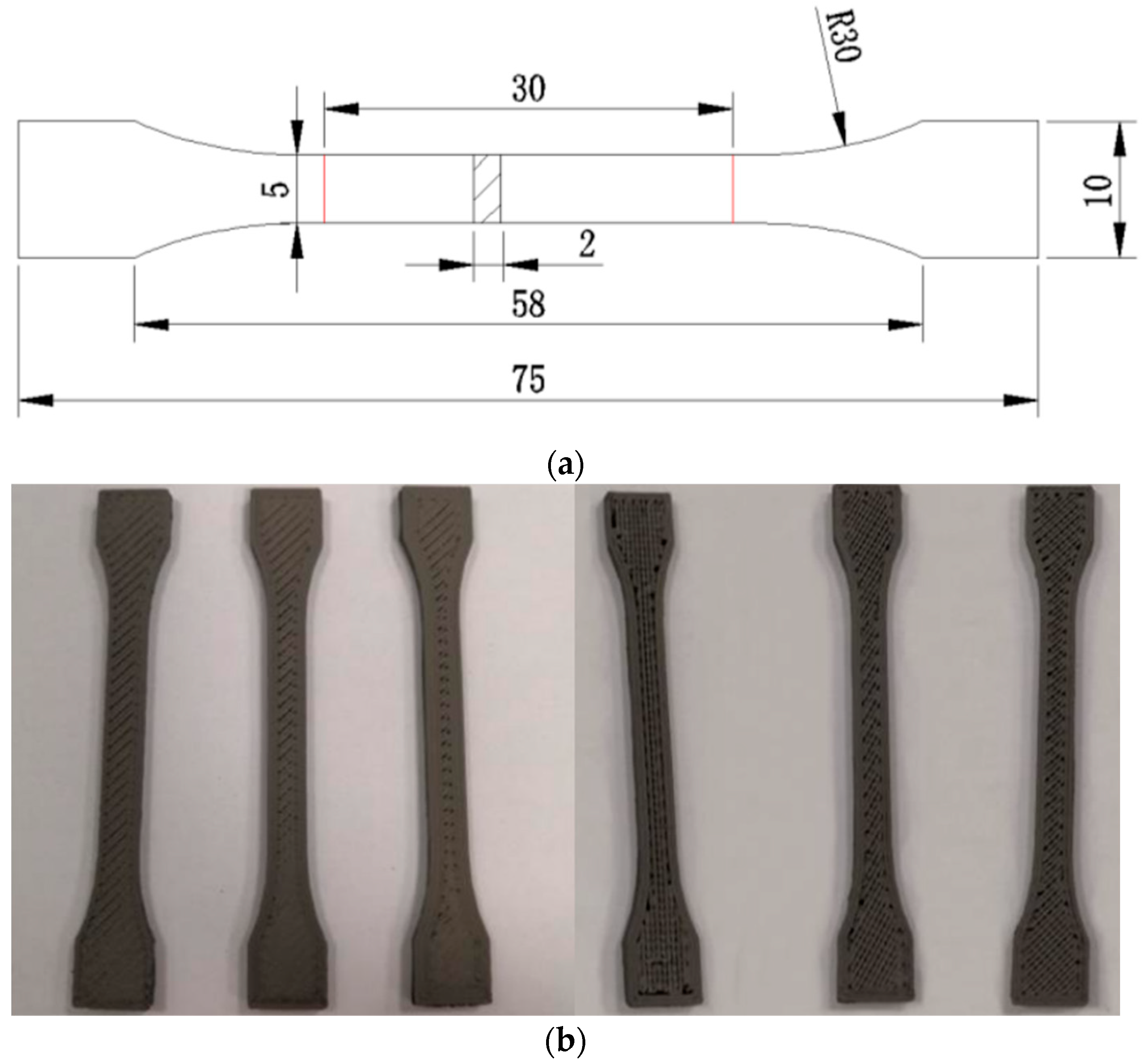
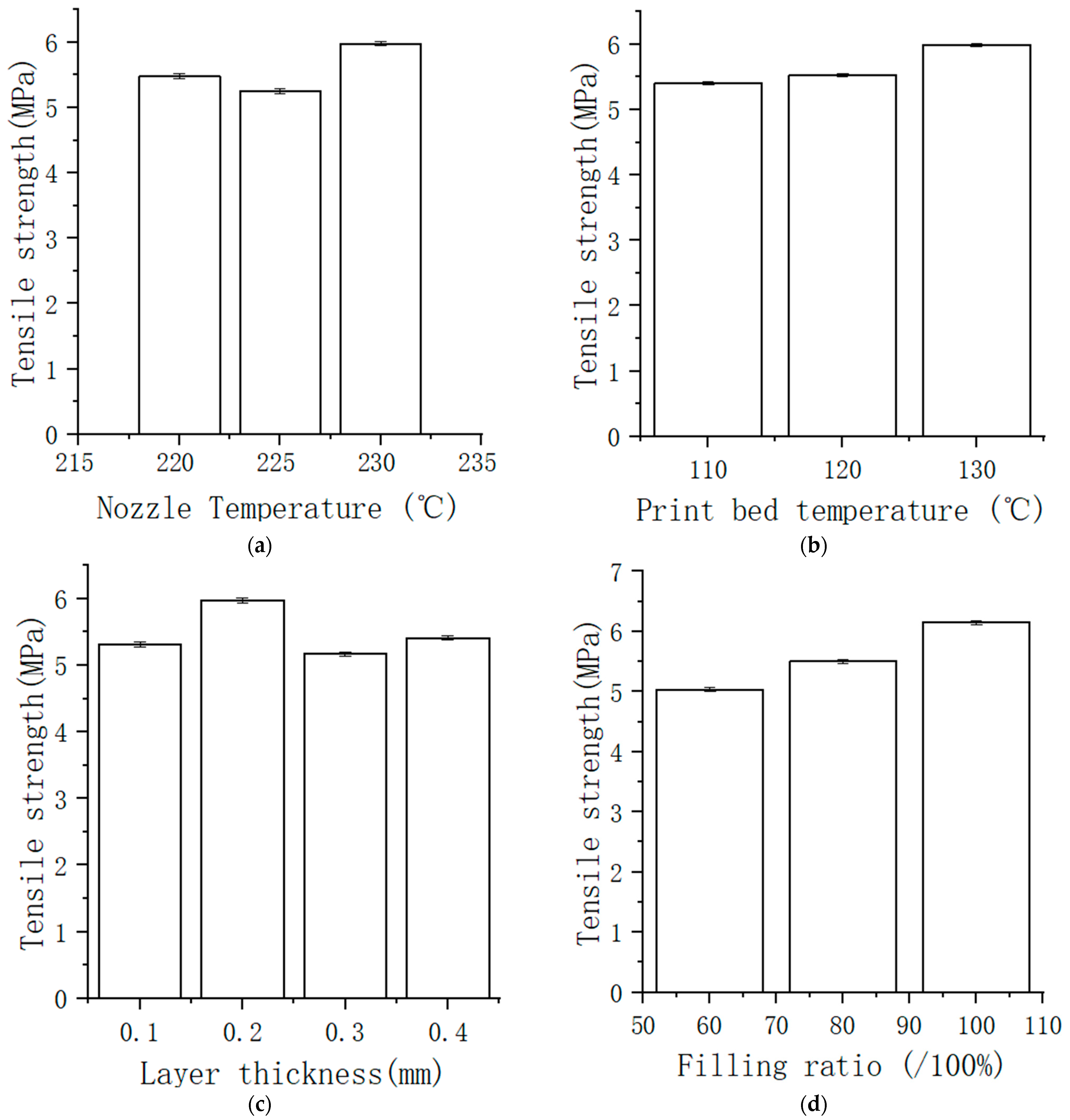
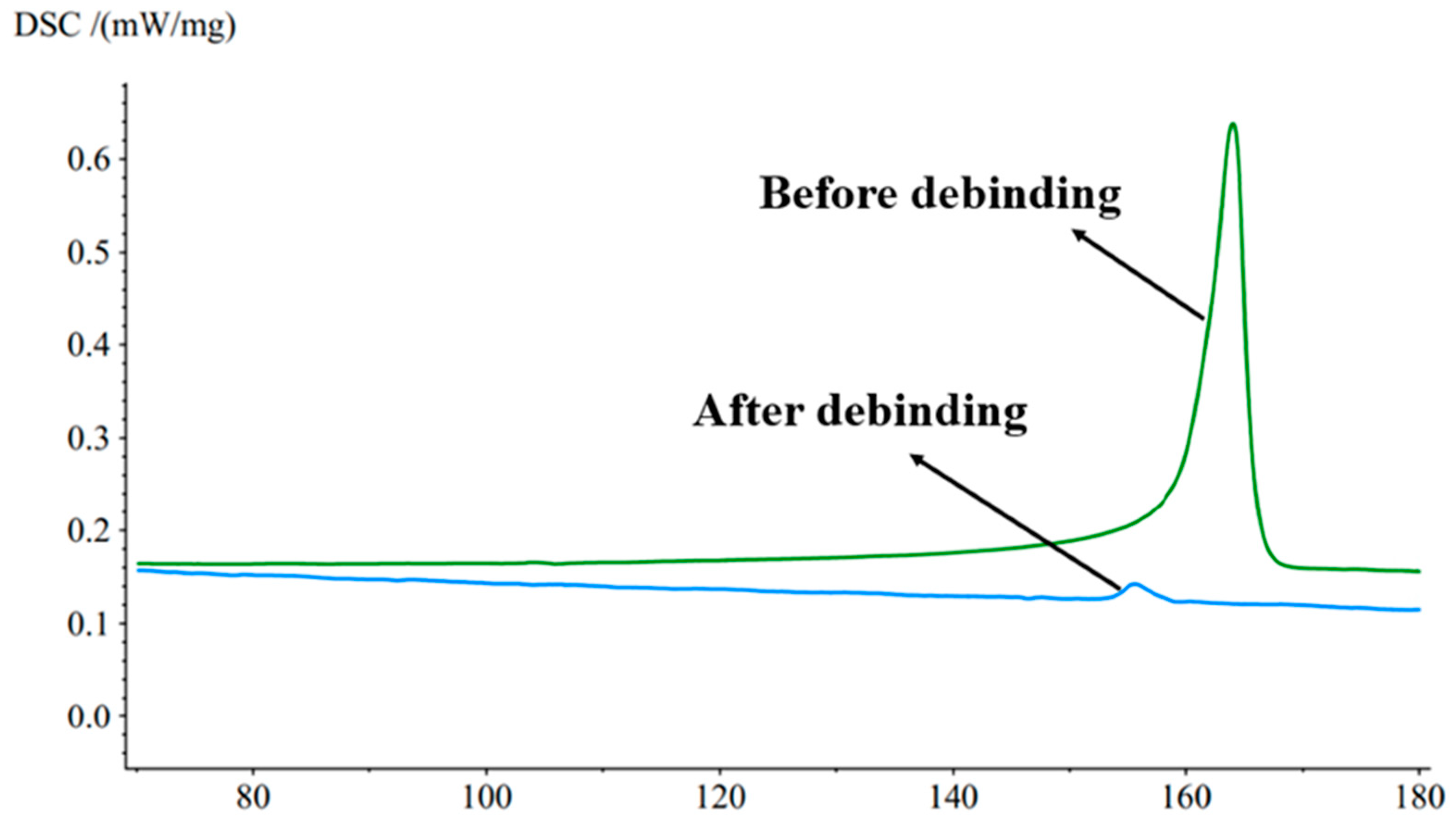
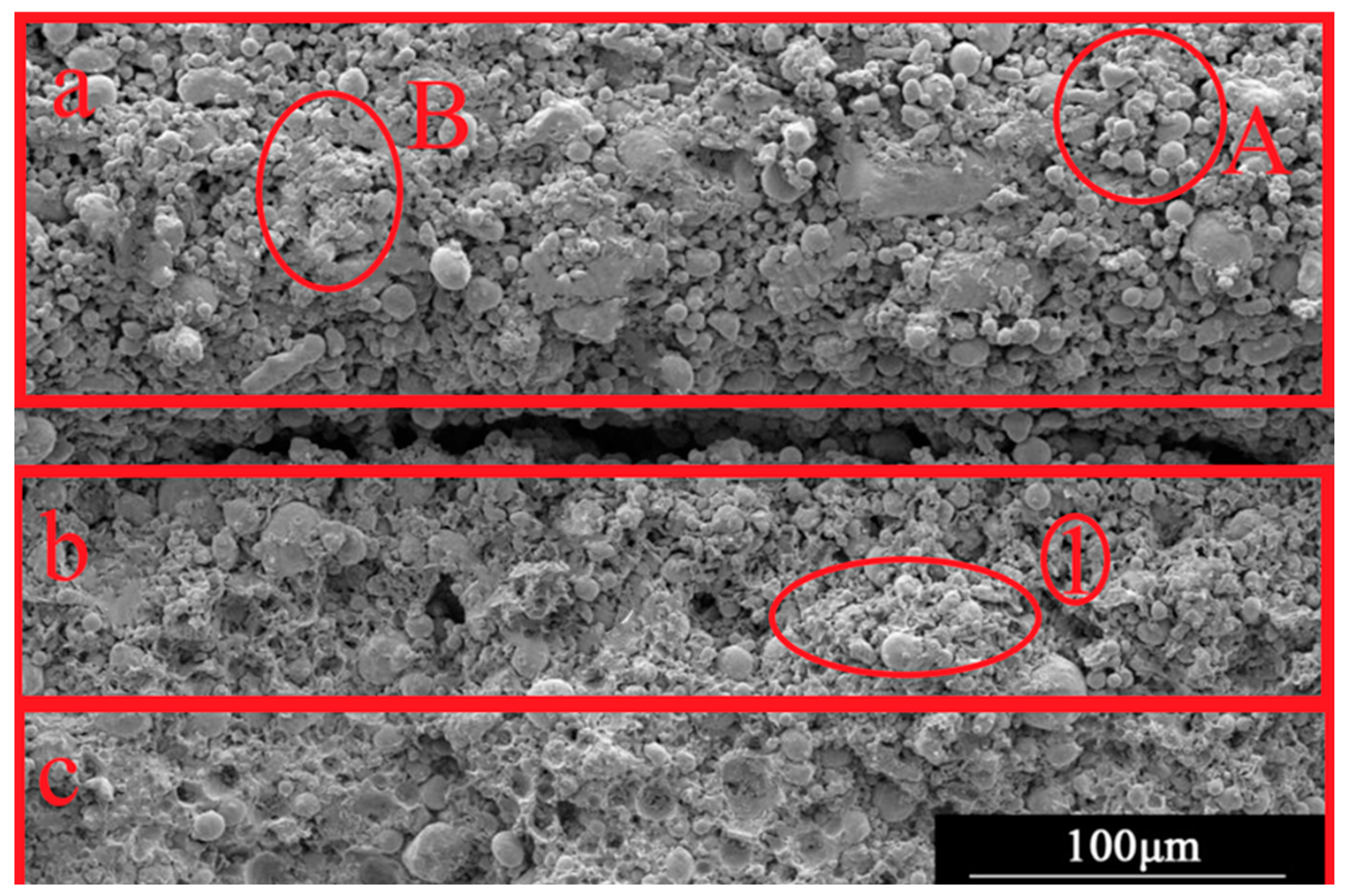

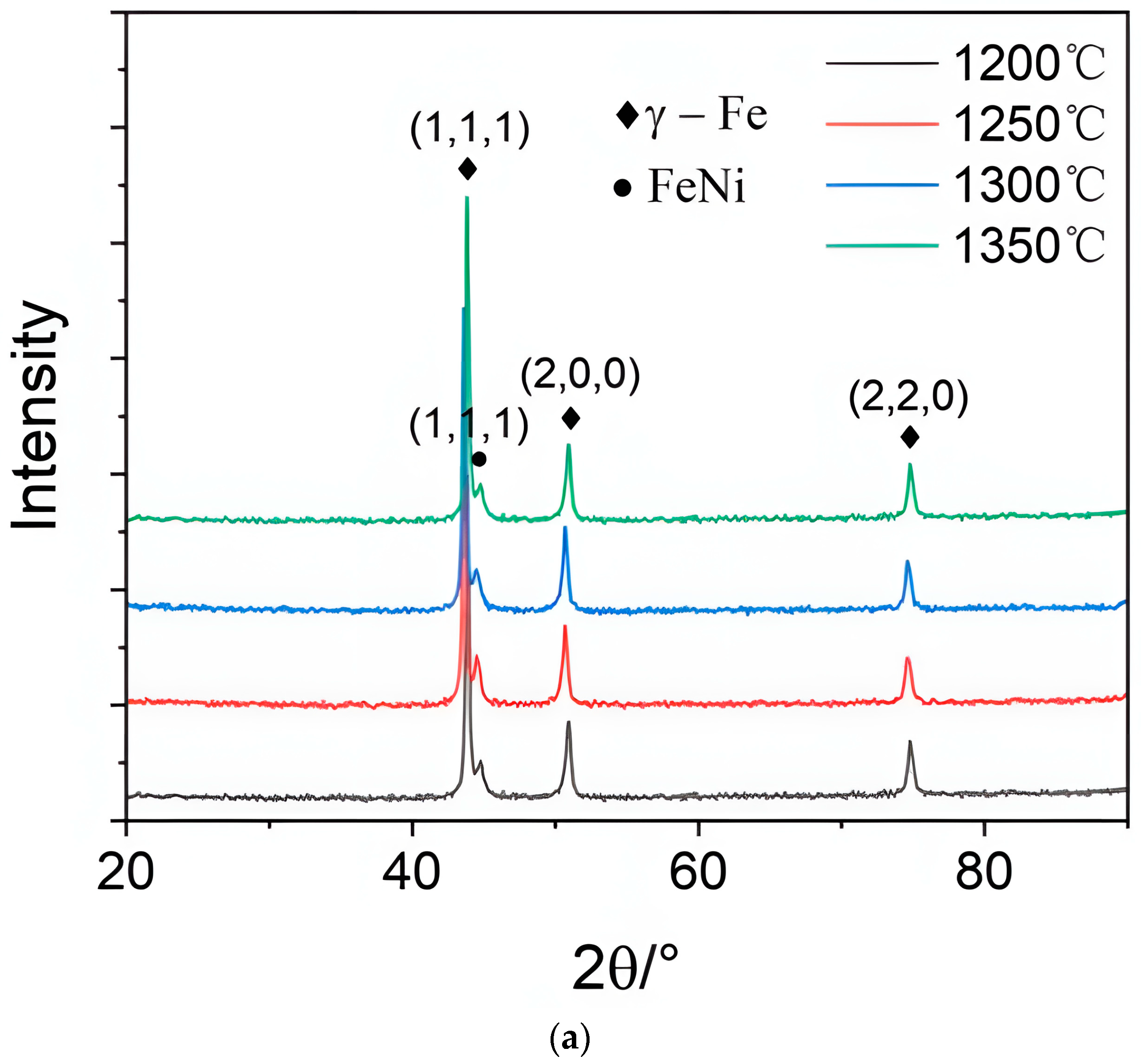

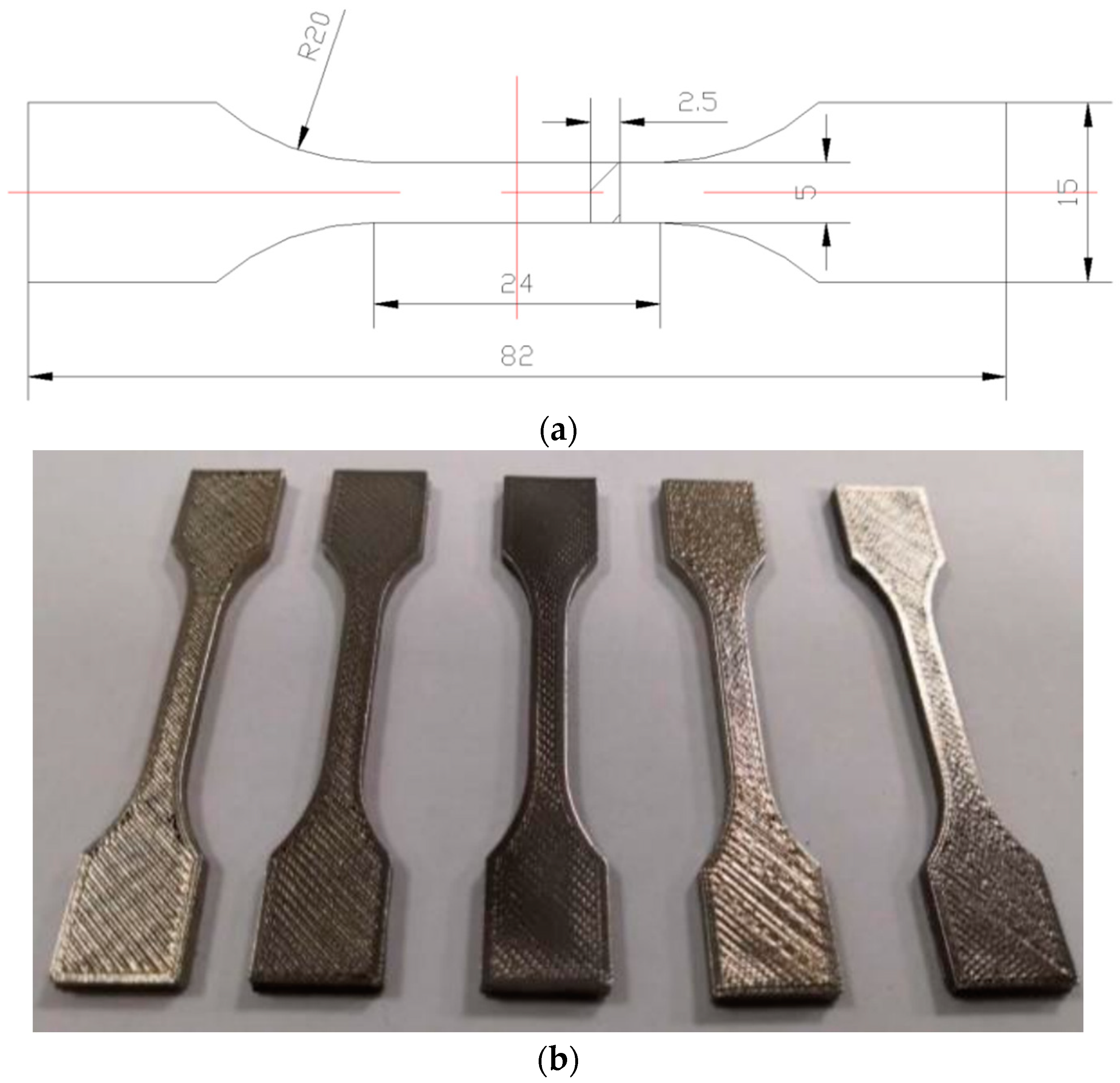
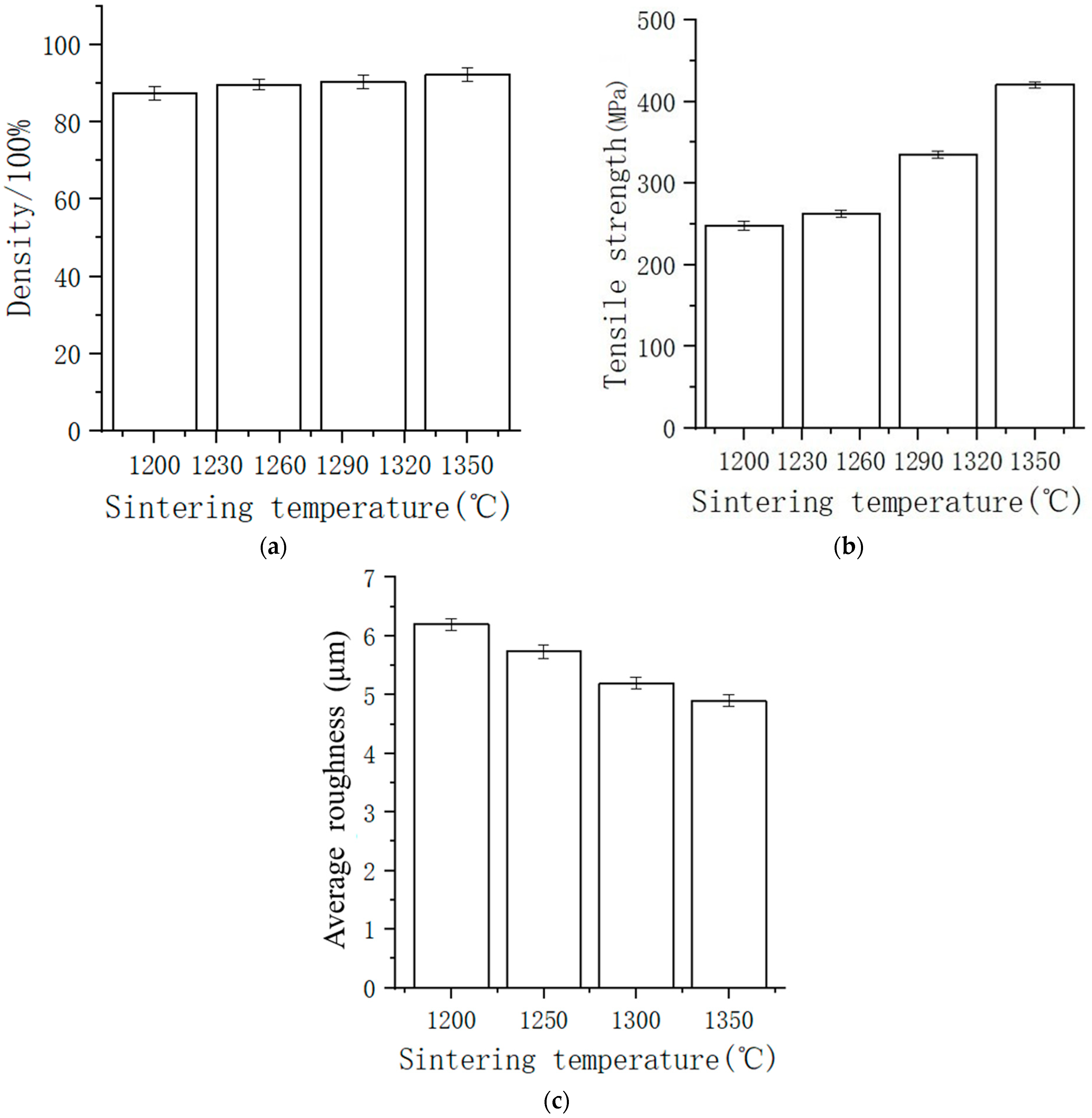
| Raw Material | Content (by Weight) |
|---|---|
| 316L stainless steel powder | 86% |
| Polyoxymethylene (POM) | 11% |
| Polypropylene (PP) | 1% |
| ZnO | 1% |
| Mixture of dioctyl phthalate (DOP) and dibutyl phthalate (DBP) | 1% |
| Parameters | Default Values | Alternative Values |
|---|---|---|
| Nozzle temperature/°C | 230 | 220, 225 |
| Print bed temperature/°C | 130 | 110, 120 |
| Layer thickness/mm | 0.2 | 0.1, 0.3, 0.4 |
| Filling rate/100% | 160 | 80, 100 |
| Experimental Level | A. (°C) | B. (°C) | C. (mm/s) | D. (mm) | E. (°C) | F (mL/min) | G (°C) | H (h) |
|---|---|---|---|---|---|---|---|---|
| 1 | 215 | 110 | 20 | 0.1 | 110 | 0.05 | 1200 | 2 |
| 2 | 220 | 115 | 25 | 0.2 | 120 | 0.15 | 1250 | 2 |
| 3 | 225 | 120 | 30 | 0.3 | 130 | 0.25 | 1300 | 2 |
| 4 | 230 | 125 | 35 | 0.4 | 140 | 0.35 | 1350 | 2 |
| Sintering Temperature (°C) | I(111)γ/I(111)FeNi | Grain Size | |
|---|---|---|---|
| D(111)γ/nm | D(111)FeNi/nm | ||
| 1200 | 0.814/0.811 | 40.3 | 12.8 |
| 1250 | 0.801/0.196 | 42.8 | 13.3 |
| 1300 | 0.763/0.231 | 41.7 | 15.8 |
| 1350 | 0.748/0.242 | 43.9 | 16.2 |
| Number | A | B | C | D | E | F | G | Tensile Strength (Mpa) |
|---|---|---|---|---|---|---|---|---|
| 1 | 1 | 1 | 1 | 1 | 1 | 2 | 1 | 247.8 |
| 2 | 1 | 2 | 2 | 2 | 2 | 3 | 2 | 264.2 |
| 3 | 1 | 3 | 4 | 3 | 3 | 1 | 3 | 334.2 |
| 4 | 2 | 4 | 3 | 4 | 4 | 4 | 4 | 412.5 |
| 5 | 2 | 2 | 3 | 1 | 4 | 1 | 3 | 330.9 |
| 6 | 2 | 1 | 2 | 3 | 3 | 2 | 4 | 416.2 |
| 7 | 3 | 3 | 1 | 4 | 2 | 3 | 2 | 272.8 |
| 8 | 3 | 4 | 4 | 2 | 1 | 4 | 1 | 256.3 |
| 9 | 3 | 1 | 2 | 3 | 4 | 3 | 2 | 270.6 |
| 10 | 4 | 4 | 1 | 2 | 3 | 4 | 4 | 420.8 |
| 11 | 4 | 3 | 4 | 1 | 2 | 2 | 3 | 340.8 |
| 12 | 4 | 2 | 3 | 4 | 1 | 1 | 1 | 250.6 |
| K1 | 864.2 | 934.6 | 941.4 | 919.5 | 754.7 | 915.7 | 754.7 | |
| K2 | 1159.6 | 845.7 | 951 | 941.3 | 877.8 | 1004.8 | 807.6 | |
| K3 | 799.7 | 947.8 | 994 | 1021 | 1171.2 | 807.6 | 1005.9 | |
| K4 | 1012.2 | 1089.6 | 931.3 | 935.9 | 1014 | 1089.6 | 1249.5 | |
| k1 | 288.1 | 311.5 | 313.8 | 306.5 | 251.6 | 305.2 | 251.6 | |
| k2 | 386.5 | 281.9 | 317 | 313.8 | 292.6 | 334.9 | 269.2 | |
| k3 | 266.6 | 315.9 | 331.3 | 340.3 | 390.4 | 269.2 | 335.3 | |
| k4 | 337.4 | 363.2 | 310.4 | 311.9 | 338 | 363.2 | 416.5 | |
| Range (R) | 119.9 | 81.3 | 20.9 | 33.8 | 138.8 | 94 | 164.9 | |
| Degree of Influence | G > E > A > F > B > D > C | |||||||
| Optimal Solution | A2B4C3D3E3F4G4 | |||||||
Disclaimer/Publisher’s Note: The statements, opinions and data contained in all publications are solely those of the individual author(s) and contributor(s) and not of MDPI and/or the editor(s). MDPI and/or the editor(s) disclaim responsibility for any injury to people or property resulting from any ideas, methods, instructions or products referred to in the content. |
© 2023 by the authors. Licensee MDPI, Basel, Switzerland. This article is an open access article distributed under the terms and conditions of the Creative Commons Attribution (CC BY) license (https://creativecommons.org/licenses/by/4.0/).
Share and Cite
Wu, S.; Li, H.; Han, C.; Wu, W. Effects of Full Chain Processes on the Performance of 316L Stainless Steel Composite by Fused Deposition Modeling and Sintering. Metals 2023, 13, 2022. https://doi.org/10.3390/met13122022
Wu S, Li H, Han C, Wu W. Effects of Full Chain Processes on the Performance of 316L Stainless Steel Composite by Fused Deposition Modeling and Sintering. Metals. 2023; 13(12):2022. https://doi.org/10.3390/met13122022
Chicago/Turabian StyleWu, Shenglin, Haoxin Li, Chongyang Han, and Weibin Wu. 2023. "Effects of Full Chain Processes on the Performance of 316L Stainless Steel Composite by Fused Deposition Modeling and Sintering" Metals 13, no. 12: 2022. https://doi.org/10.3390/met13122022




